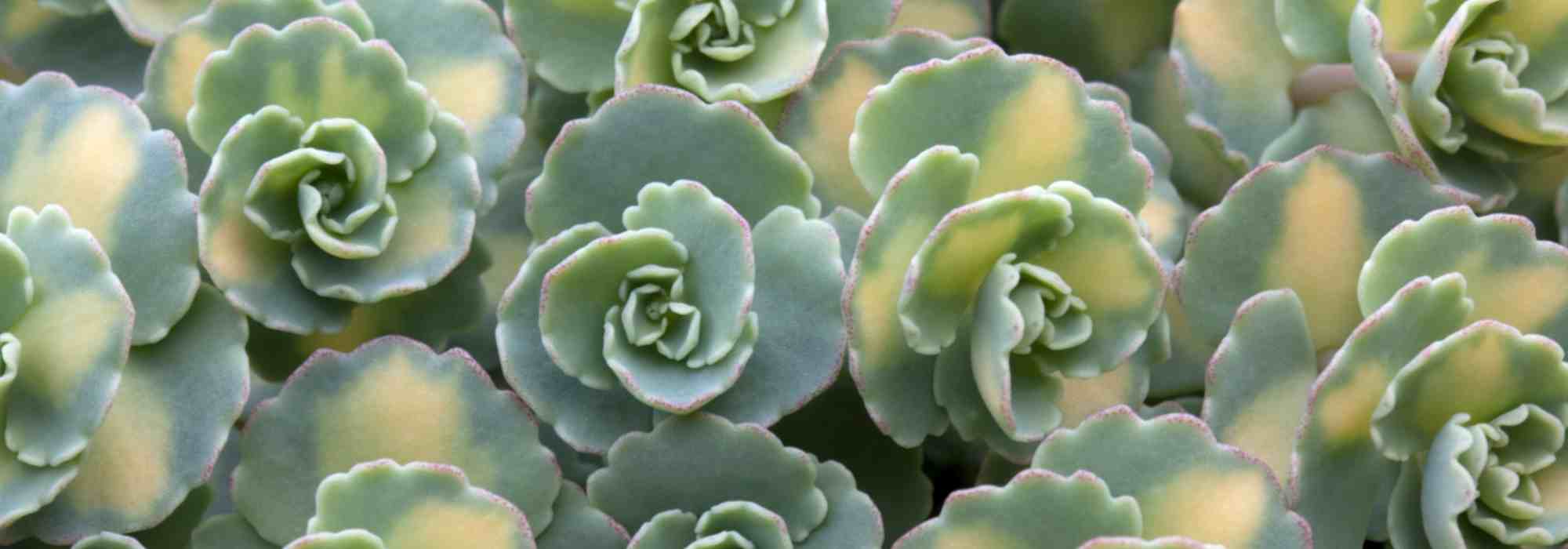
Sedum: 7 groundcover species and varieties
Selection of easy-to-grow and ornamental varieties
Contents
Among Sedums (often encountered under the name Hylotelephium), some are exceptional groundcovers. Thanks to their ability to creep across soil, their stems spread and root progressively, without becoming invasive. They thus enable the creation of striking plant tapestries, all the more so as they are easy to grow and to maintain. To perform at their best, they need very well-drained soil, even dry, poor and stony, and a very sunny position. This ability to withstand drought and heat makes an ideal plant given changing climate and watering restrictions that gardeners increasingly face in summer. They can just as easily be planted in a border as be used in pots, in rockeries or on top of a wall. They are also widely used in construction of green roofs. I present here a list of 7 creeping Sedums with vibrant foliage and flowering, and also offer some companion plant ideas that enjoy similar growing conditions.
Sedum pachyclados
Artichoke sedum (Sedum pachyclados) has an original, graphic leaf display, which is evergreen to semi-evergreen depending on winter severity. Thick, succulent leaves with irregularly dentate tips are arranged in glaucous green rosettes, resembling miniature roses. In time, this groundcover Sedum forms a handsome tapetum spreading to about 30 cm. At the end of spring (between June and July), numerous star-shaped flowers unfold just above the leaves, reaching a height of about ten centimetres. Pale yellow in colour, they may show orange tints, the centres of the corollas being darker.
- Possible companion plants : Artemisia with attractive grey leaf, larger Sedum with autumn flowering, other groundcover plants such as Iberis (white spring flowering) or Saponaria ocymoides (pink flowering that coincides with that of Sedum pachyclados), and the lightness of a few tufts of architectural grasses, such as Fescues with blue-tinged leaves.
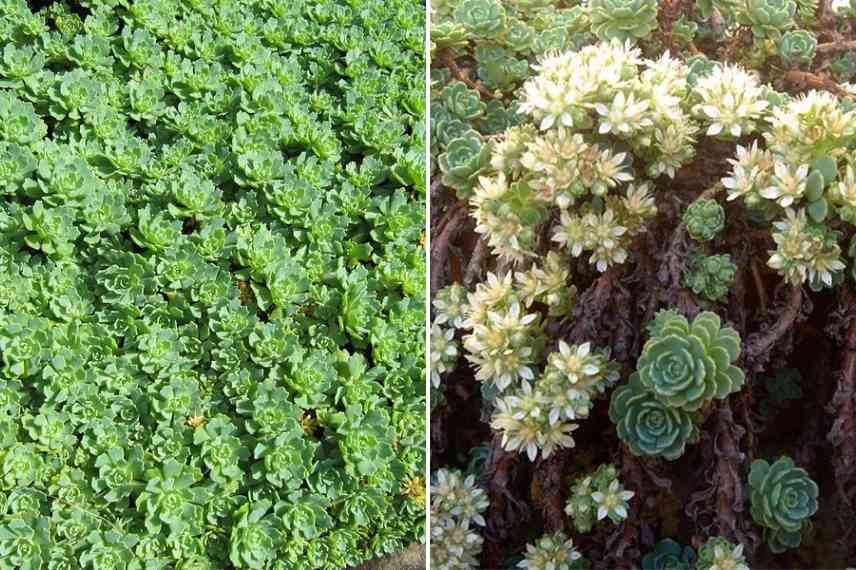
Sedum Pachyclados as ground cover on the left (Photo: L. Enking), and flowering on the right
Read also
Sedum or orpin: which variety to choose?Sedum 'Bertram Anderson'
Sedum ‘Bertram Anderson’ is a beautiful Sedum groundcover variety, with oblong to ovate, flat, fleshy leaves inserted alternately along long creeping stems. Slightly dentate, they display unusual, changing colours: bluish-grey with green and pink highlights, gradually tinging violet and purple depending on exposure and humidity. Between July and September, star-shaped, melliferous flowers open, in a pink that deepens as the season progresses.
- Possible companion plants : Tufts of Italian Everlastings (or curry plant because of its curry-like scent), Euphorbias, with unusual flowering and graphic foliage, sometimes in surprising colours, garden valerian (which add height and colour in spring), dwarf asters to flower in autumn, and the fine foliage of Stipa tenuifolia which punctuates the scene and dances at the slightest breeze.
Discover other Sedum
View all →Available in 0 sizes
Available in 1 sizes
Available in 1 sizes
Available in 2 sizes
Available in 3 sizes
Available in 0 sizes
Available in 2 sizes
Available in 0 sizes
Available in 1 sizes
Available in 1 sizes
Sedum sieboldii
Sedum sieboldii is a creeping stonecrop with attractive deciduous foliage, rounded, bluish in colour, often edged with a pink margin. This colour can sometimes also spread across the entire lamina, even becoming distinctly red. The stems, long and flexible, are also tinged purple and spread to form a dense, low mound (15 cm x 30 cm), which bears dark-pink globular inflorescences from September to October.
- Possible companion plants: colourful carpets of Aubrietas (white or varying shades of pink spring flowering) or Arabis, taller, very architectural perennials such as tall foxtail lilies, elegant, airy ornamental grasses, such as Stipa gigantea.
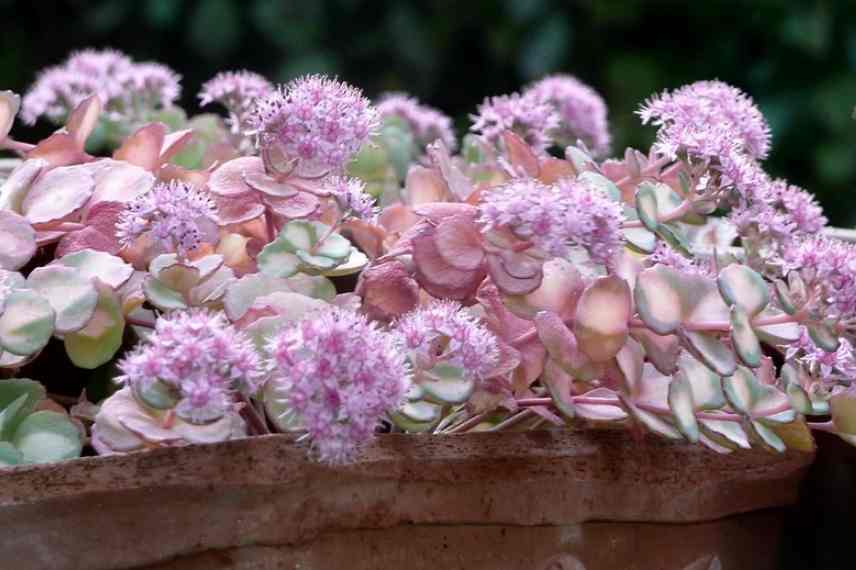
Sedum sieboldii (photo: C. Sanvito)
Sedum kamtschaticum
Kamtchatka stonecrop offers compact growth, which allows creation of beautiful cushions with semi-evergreen foliage. 10 cm high with 25 cm spread, this small perennial groundcover displays throughout the season a crenate, leathery foliage of a lovely green, which may turn red as autumn approaches. Its very small star-shaped flowers appear in abundance between July and September. Yellow, they are brightened by a more orange centre, before turning pink as they fade.
- Possible companion plants: Wall bellflowers (very attractive blue flowering), Ballota (with silvery-green foliage, soft as velvet), Sages (in a range of attractive colours), Stipa arundinacea ‘Sirocco’ (its evergreen foliage takes on lovely coppery hues).
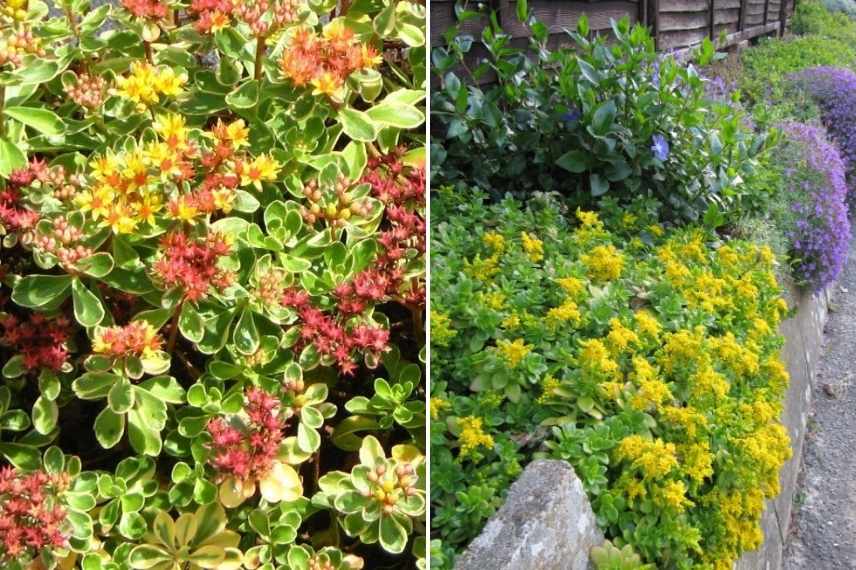
Sedum kamtschaticum (Right-hand photo: L. Enking)
Sedum sexangulare
Sedum sexangulare is also called six-angled orpine because of its very unusual foliage. Small succulent, evergreen leaves are arranged in six ranks, forming a spiral, which gives it a very distinctive, somewhat amusing appearance. With fresh green foliage, leaves can turn red, and this perennial for dry soil eventually forms a low, creeping clump (10 x 30 to 45 cm), thanks to stems that root on contact with soil. In early summer, small star-shaped flowers, a bright yellow, emerge from foliage in flattened clusters, called corymbs, which attract pollinating insects.
- Possible companion plants: Saxifrages (some of which also form beautiful colourful cushions), Lavenders (for their grey foliage and scented flowering), Red hot pokers (they offer warm colours and an equally distinctive look), Mountain Sandworts (another easy-to-grow groundcover), Moss phlox (their generous spring flowering is irresistible).
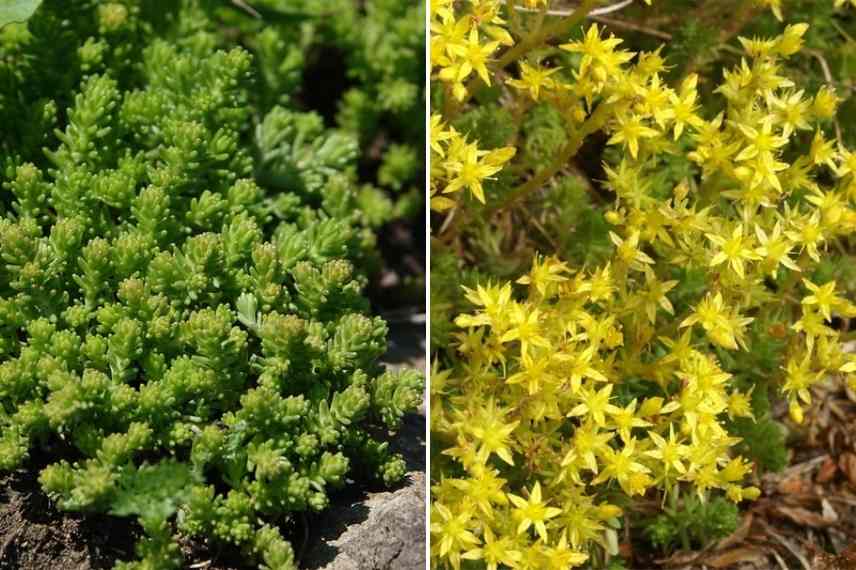
Sedum sexangulare :foliage on left (photo: G. van Noord), and bright flowering on right
Sedum 'Sunsparkler Wildfire'
This recent hybrid variety stands out for its striking, highly decorative and strongly tinted foliage. Deciduous leaves of Sedum ‘Sunsparkler Wildfire’ are round and flattened, and their colouring of a deep red reveals a bluish to greenish tinge at the base, all delicately highlighted by a dark pink margin. In summer, and continuing into autumn, the reddish-pink flowering confirms these warm colours, forming small flower spikes that reach about twenty centimetres. This Sedum retains a compact form, even at its centre, and while it prefers full sun, it can nevertheless tolerate very light shade.
- Possible companion plants : des Erigerons karvinskianus (their long-lasting flowering displays pinkish hues that echo those of this sedum), blue oat-grass (a grass with a very graphic habit and an intriguing metallic blue), another Sedum with lime-green tones such as Sedum makinoi ‘Lime’, houseleeks (their multicoloured rosettes of foliage and sparkling flowering make them excellent companions for Sedums), Eryngium (some varieties offer stunning silvery blues, together with very architectural foliage and flowering).
Sedum reflexum 'Angelina'
Sedum reflexum ‘Angelina’ could be likened to a miniature conifer with its small, slender, pointed leaves resembling needles. This groundcover orpine forms a low cushion about 15 cm high and has a spreading habit reaching nearly 45 cm, in tones of chartreuse green in season. Its colours then shift towards bronze and orange as temperatures cool, and its decorative foliage persists throughout winter. All summer, this tapetum transforms into a sheet of small yellow flowers, much visited by pollinators.
- Possible companion plants: Santolinas (with grey foliage and yellow flowering), large Perovskias (their erect habit and blue flowering bring very attractive pits above the yellow foliage of this Sedum), a Fuchsia of California (its very generous summer flowering, red‑orange, is sure to catch the eye), Nepetas (variety ‘Cat’s Pajamas’ maintains a compact habit that showcases its long indigo‑blue flowering).
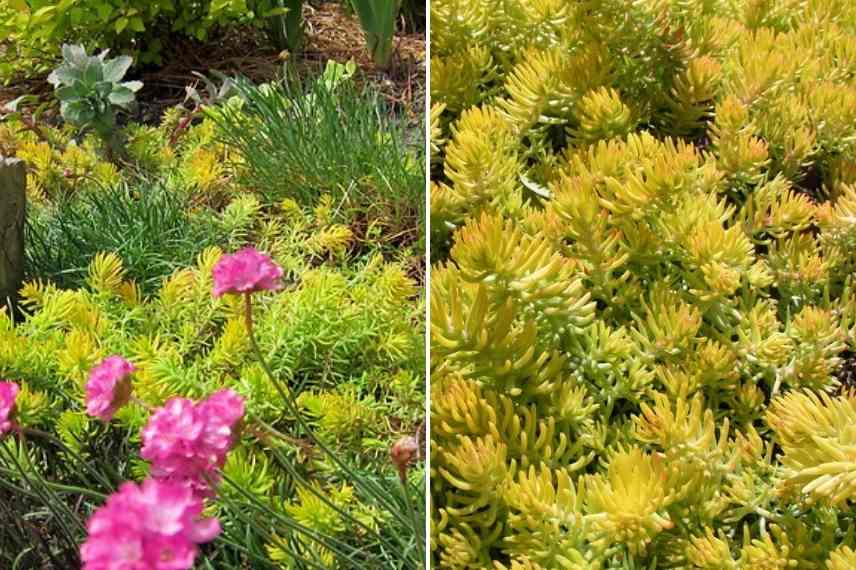
Sedum reflexum ‘Angelina’ : planted in a mixed border with Armeria maritima on the left (photo: KM), and golden foliage on the right
- Subscribe!
- Contents
































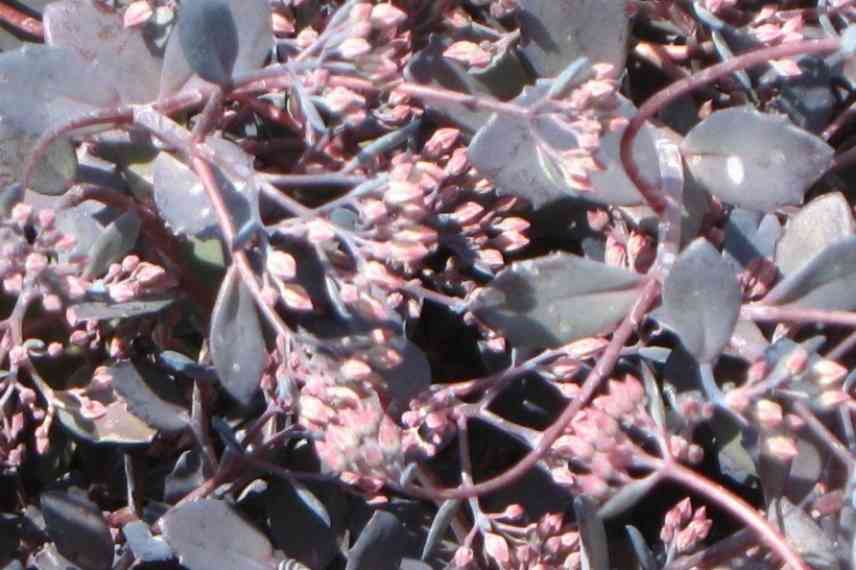
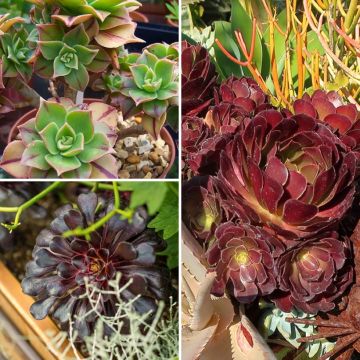
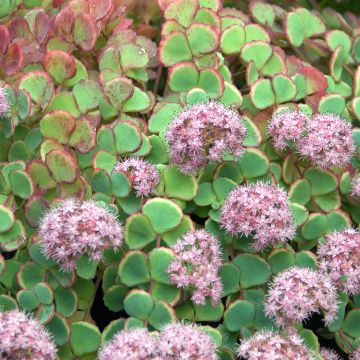
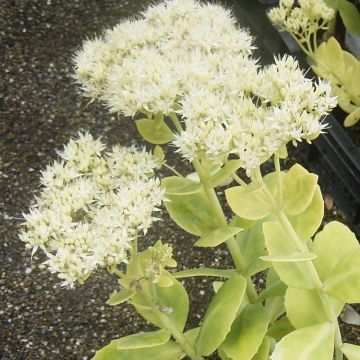
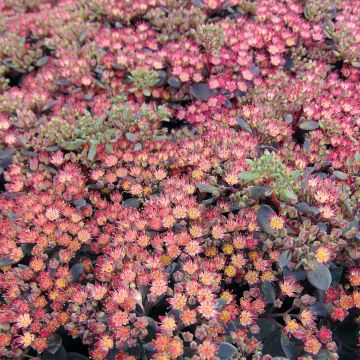
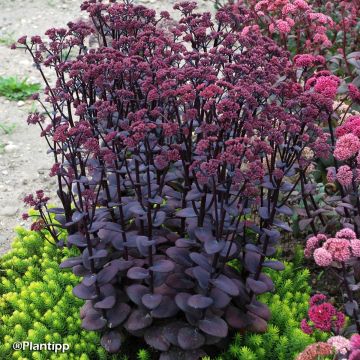
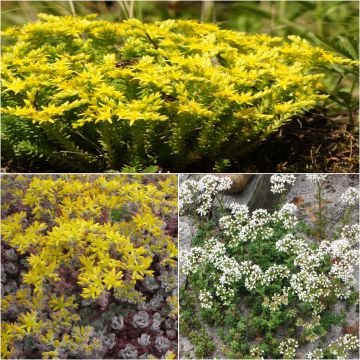
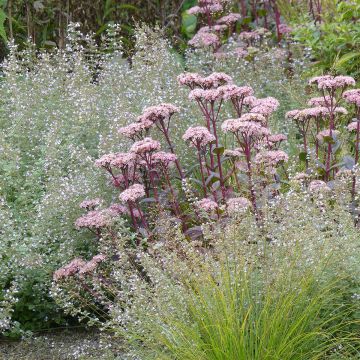
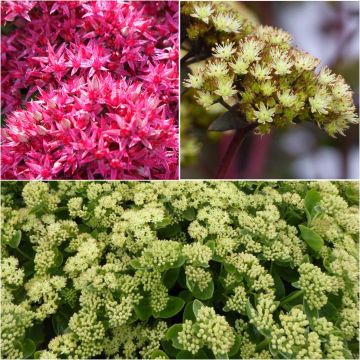
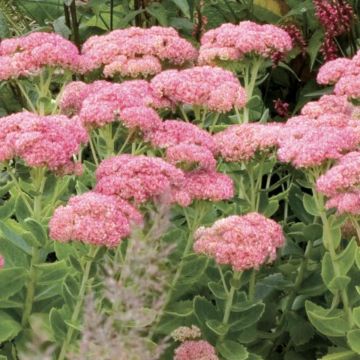
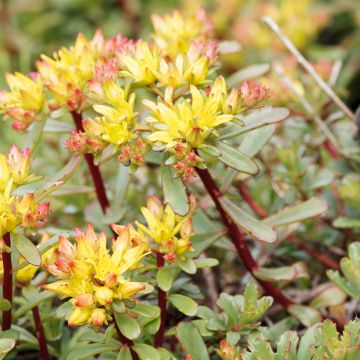
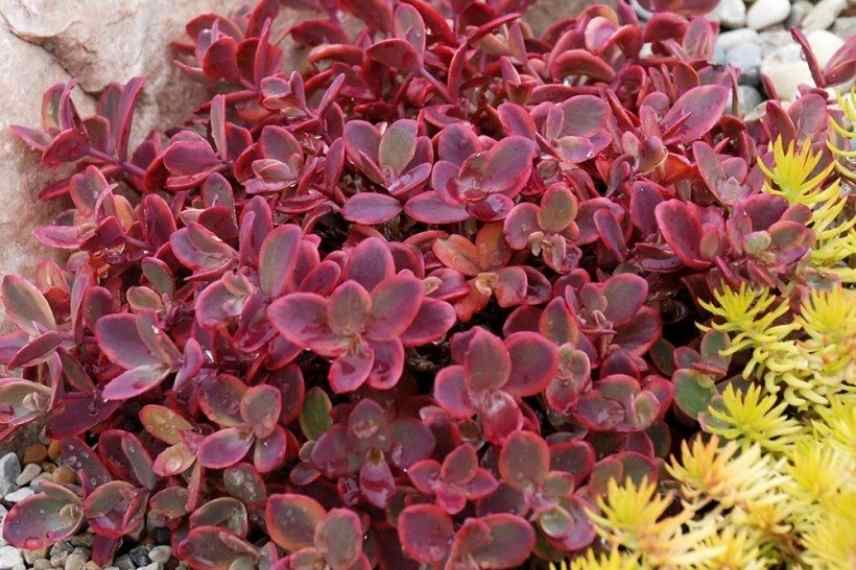
Comments